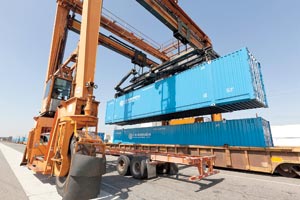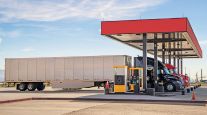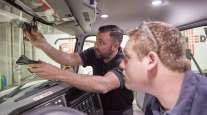‘Where’s My Freight?’

This story appears in the Nov. 16 print edition of iTECH, a special supplement to Transport Topics.
Today’s tracking technology allows users to monitor the movement of goods from the time they leave the manufacturer to the final unloading, eliminating black holes that once existed within the system, particularly within the handoff points as loads changed hands. As a result, carriers are able to improve customer service, minimize delays, better utilize assets and enhance security. The ability to track loads also opens up new opportunities for carriers as more shippers require up-to-date information on a load’s location.
“Everybody wants to know everything right now. The glory of technology and tracking is that you get that option,” said Shawn Zerges, director of information technology for SNL Distribution Services Corp., based in Birmingham, Alabama.
TRAILER TRACKING: Helps carriers manage regulatory requirements
All parties along the supply chain want eyes on a shipment, and more companies are demanding transparency from their business partners, said Glynn Spangenberg, a senior vice president for MacroPoint, a tracking technology provider based in Independence, Ohio. “If you have tracking, you have the ability to haul Amazon freight because Amazon has a very strict requirement for where that load is,” he said.
What’s more, users want one-stop shopping when it comes to how they view their information, said Ken Weinberg, executive vice president of Carrier Logistics Inc., based in Tarrytown, New York. As a result, technology providers are pulling in data from many sources to provide the final information a customer sees.
Weinberg said Carrier Logistics is “hardware agnostic” and can pull data from many devices. “As long as they can send us a status message, we are able to take it into our application and disseminate it to the users,” he said, adding that information can be transmitted via cellular or satellite communications or underground cable from the Orient. “A status message from a ship would come as a satellite communication sent to a base station, then we could take it to our application and update the status of it within our system and communicate it,” he said.
Carriers can use a number of hardware options for tracking trailers and intermodal containers, but the devices are just part of the equation. “The hardware is part of the onboarding, but the more critical part is getting the integration of the data into the pools of information the company currently uses,” said Henry Popplewell, president of SkyBitz, a tracking technology provider based in Herndon, Virginia.
Users can access SkyBitz tracking information via a SkyBitz portal, or the company can deliver information through a transportation management system, such as those offered by TMW Inc. or McLeod Software, or into another system the customer specifies.
For Eden Prairie, Minnesota-based C.H. Robinson Worldwide, integrating tracking information from devices installed on intermodal containers along with updates to radio frequency identification devices sent from the railroad into its system provide seamless reporting across modes, said Phil Shook, director of intermodal for C.H. Robinson.
“We have a feed from the railroad to our intermodal business, but it feeds into our global technology that is a common platform for the organization,” Shook said, adding that the company uses tracking from I.D. Systems on its containers. “It gives us a report at the beginning and the end of the movement. That happens whether it is on the rail or on the road.”
I.D. Systems, of Woodcliff Lake, New Jersey, provides critical event information on a load, such as when it is loaded, when it unloads and when it moves. “When there is activity, we are able to capture it. We know when we’re on the rail, we know we’re at the rail yard and got loaded,” said Matt Harris, vice president of transportation sales for I.D. Systems.
Adding to the supply chain complexity, a load often experiences interim handoffs within the primary handoffs, Harris said. “You have multiple railroads and have interim handoffs, and someone can transfer to a local rail provider.”
Shook said the first and final miles of intermodal shipments are where carriers often need more information. “That is the black hole for most people,” he said. “The odds of something nefarious happen when it is out on the street somewhere, not on a train.”
Orbcomm, a provider of tracking software based in Rochelle Park, New Jersey, also pulls information from many sources into its Orbcomm Enterprise Connect system, giving customers the ability to control and connect across many portals, said Christian Allred, senior vice president of enterprise solutions for the company.
Allred said tracking is particularly helpful within intermodal because there are many handoffs along the route, and companies may rely on third-party haulers to complete a delivery.
Orbcomm created custom reporting for Hub Group, an Oak Brook, Illinois-based intermodal shipping company that has 28,000 intermodal containers in transit across North America, to help the firm manage its handoffs. Hub Group ranks No. 8 on the Transport Topics Top 100 list of the largest U.S. and Canadian for-hire carriers.
“They know where the containers are when they are on the rail, but as soon as the handoff takes place from the rail to the chassis is where it becomes critical to enable your geofences and the alerts,” Allred said.
For less-than-truckload users, MacroPoint can create separate tracking sessions for parts of the load. “We do an integration into their system and tap into the manifest. When a pallet comes off, we can shut down that portion of the tracking session,” Spangenberg said.
Geofencing is an important component of tracking for providers and carriers. SkyBitz uses a series of cargo sensors and geofencing of landmarks to find trailers and determine their status. “Landmarks can be generic — cities and states and borders — or they can be custom, specific landmarks,” Popplewell said. “Knowing when a piece of equipment enters and leaves a landmark brings a lot of clarity. It eliminates complexity around that handoff.”
Popplewell said customers often use geofencing to identify when loads arrive at a port. “We can show you dots moving across the ocean, but that part of the reporting is less critical. The real value is knowing what time it enters or leaves the port,” he said.
CarrierWeb, a tracking technology provider based in Atlanta, also uses geofencing to activate devices when they hit the port. “You can track the ship from Shanghai to Long Beach, then you will see the container come alive once it enters the port,” said R. Fenton May, co-founder of CarrierWeb.
Zerges relies on hardware from CarrierWeb for tracking and has created geofences for everywhere SNL Distribution Services hauls loads. The carrier receives updates every six minutes when trailers are moving and twice a day when they are not. “If one of our bakery customers calls and asks about a load because they are waiting to crossdock it, our terminal manager can look within a minute and know exactly where the driver is,” he said.
Tracking systems work only if the information is current, and FourKites, a Chicago-based tracking software provider that pulls information from more than 30 electronic logging devices, can use geofencing to encourage updates. “When you have coordination with multiple systems, you want to make sure they’re updating their systems in a timely fashion,”
FourKites CEO Mathew Elenjickal said. “If a change didn’t happen when we thought it was going to happen, we could let them know the load entered the geofence and ask why we hadn’t gotten an update.”
With FourKites, users have one portal where they can view information from many devices. If one leg of the journey doesn’t utilize an ELD, the system can utilize a driver’s phone number to track the load. Because information on the same load can be coming from many sources as the load changes hands, FourKites can find the common identifier of a load, such as a purchase-order number, from the shipper’s transportation management system.
Spangenberg said users can rely on a location’s device to initiate a tracking session. MacroPoint also can start a tracking session based on information from the customer’s TMS, the driver’s mobile number or an in-cab device, Spangenberg said. MacroPoint can integrate with third-party providers, or users can log in directly through the MacroPoint website, Spangenberg said.
Zerges said SNL Distribution Services uses tracking to ensure the smooth handoff of loads, even along the same route. “We do drop-and-hook runs and swaps. It is seamless to us. We just see the trailer moving, and we know which driver has it because the driver puts the trailer number into his computer,” Zerges said.
The various handoff points within the supply chain create opportunities for things to go wrong, and monitoring handoffs can improve customer service, CarrierWeb’s May said. “If you expect a load to be on a train and it isn’t there, you can have a very rapid alert rather than waiting for the train to get to its destination and discovering your load isn’t there,” he said.
Elenjickal said, “As soon as the carrier knows a delay is going to happen, [the shipper] wants to know right away. We are tracking every load every 15 minutes across the carriers; we can set up rules to identify if there are delays.”
To get out ahead of any mismatches, SkyBitz integrates with TMS partners, including TMW and McLeod, to ensure the right tractor is paired with the right trailer. “If not, it raises an alert either to the screen or the handheld device of the dispatcher,” Popplewell said.
With Omnitracs’ trailer-tracking technology, if the user also has an Omnitracs in-cab unit, the two devices can talk to each other to know which trailer the tractor is connected to. “If a driver connects with the wrong trailer, the driver and the fleet manager get notified,” said Mark Alsbrook, a senior product manager for Dallas-based Omnitracs.
Carriers often hand their equipment over to shippers, either to be loaded or unloaded. Tracking technology along with cargo sensors can help carriers monitor where equipment is located and identify when it is empty, speeding turnaround times. “That box can get stuck in a yard of thousands of same size, same color boxes. Tracking lets you identify your assets quickly — you get visibility, location and status,” Harris said.
“A location may say it needs 24 hours to unload a trailer, but it could be unloaded by noon and sitting there empty. You could go pull that trailer in and get it utilized,” Alsbrook said.
Several providers, including Orbcomm, offer sensors that alert carriers when doors have been opened on equipment. “It is nice for Hub to be able to call a Home Depot or a Lowe’s and say, ‘My container arrived at your loading dock two days ago, but the cargo doors haven’t been opened,’ ” Allred said. “They’re trying to speed up that downtime.”
To help hasten deliveries, MacroPoint can integrate with a customer’s warehouse management system so those on the receiving end know exactly when the load is coming and can staff accordingly.
SkyBitz has introduced tracking technology for intermodal chassis that will pinpoint the location of the chassis and identify whether it is loaded. “The companies that own the intermodal container don’t own the chassis. The chassis owner needed something that would let them know if the chassis had a container on it,” Popplewell said.
For SNL Distribution Services, tracking facilitates handoffs internally within the carrier to the maintenance department. “If there is a trailer with an issue, maintenance wants to know so they can find it and it gets pulled in before someone takes it out again,” Zerges said.




